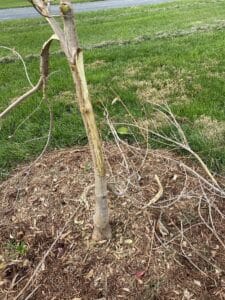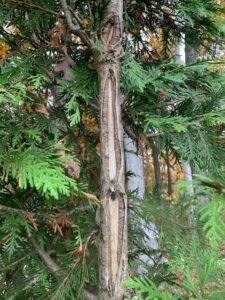Hello fellow readers, When I moved to the area and saw Deer Corn for Sale signs, I considered it a tool to lure deer during hunting season. I quickly learned that folks buy it to feed deer all winter long. While their intentions of being kind to wildlife are good, feeding deer promotes disease and can encourage deer rub.
Deer Feeding promotes disease devastating to deer.
 Their natural way to survive in the winter months is to move less by hunkering down to stay warm, relying on their fat reserves. The energy to seek out feeding sites depletes these reserves. The Pennsylvania Game Commission summarizes feeding deer this way: “energy-wise it’s a losing proposition like a motor burning 3 gallons of gas to go buy only 2 gallons of gas.”
Their natural way to survive in the winter months is to move less by hunkering down to stay warm, relying on their fat reserves. The energy to seek out feeding sites depletes these reserves. The Pennsylvania Game Commission summarizes feeding deer this way: “energy-wise it’s a losing proposition like a motor burning 3 gallons of gas to go buy only 2 gallons of gas.”
Supplemental feeding causes an unnatural deer density that encourages deadly diseases to spread, such as Chronic Wasting Disease and Tuberculosis. Nope, deer won’t wear masks or keep the 6-foot rule.
Chronic Wasting Disease & Tuberculosis
Chronic Wasting Disease (CWD) is a neurological sickness found in twenty-six states, including New York, Pennsylvania, but not yet in New Jersey. No convincing evidence exists that CWD can infect people, though research is underway per the Centers for Disease Control. However, hunters can contract Tuberculosis (TB) during field dressing through deer infected with Mycobacterium Bovis. However, by far, most TB cases in humans are caused by different bacteria.
A concentrated grain diet, typically corn, can be deadly to deer. Deer feed on woody and green plants and the transition of concentration from one to the other is gradual once spring sprouts new growth. A sudden introduction of grains can cause “a fatal disruption of the animal’s acid-based balance” in their digestive system. “Those that survive the immediate effects often die due to secondary complications of diseases.”
Sadly, I saw a sign for Deer Apples on a basket of bruised fruit not long ago. While apples won’t harm them, the more deer that unnaturally survive the winter will cause larger but weaker herds and not enough food to go around. Hence the deer dilemma for farmers, gardeners, and homeowners that goes beyond deer browse.
About Deer Rub
Within a week, I heard from two clients who sent photos of young trees devastated by deer rub, also known as buck rub. Both have dogs who enjoy the chase, which is an effective deterrent. Unfortunately, deer rub usually occurs after dark when furry kids are inside.
Male deer (bucks) grow a new set of antlers each year. Come fall, they rub away the velvety covering using young trees, which also serves as marking territories. Deer rub makes trees vulnerable to disease and cuts off their transport systems (xylem and phloem) that supply water and nutrients to the tree, damaging or killing it. If the rubbing is only on one part of the trunk, trees will likely recover by healing over the wound.
How to Protect Trees fromDeer Rub
There are corrugated plastic tree guards you can buy to place around trunks to prevent deer rub. Be sure they are light-colored on the outside to keep heat from developing, causing the bark to crack or blister. There are metal mesh tree guards, or vinyl spiral wraps too. On evergreens needled to the ground, stakes around the trees to set up temporary fencing around them is the best option. They sell sprays also, but most don’t believe them to be effective. Protect trees at least five feet from the ground.
Speaking of feeding wildlife, I recently visited John on Hathorn Lake in Greenville, NY, and found a Winterberry (Ilex verticillata) devastated by beaver. The neighbor’s maple tree is also severely damaged.
“My neighbor feeds apples to the beaver,” he said.
While I couldn’t find information about the negative health impact of feeding beaver, apples are not part of their natural diet. And feeding beaver (or deer) encourages them to hunker down near you. Better to bake an apple pie. Garden Dilemmas? AskMaryStone@gmail.com (and now on your favorite Podcast App.)
Link to a previous article with other DIY options to prevent deer rub – Buck Rub
Helpful links:
Center for Disease Control (CDC) about Chronic Wasting Disease
Link to Pennsylvania Game Commission pamphlet Please Don’t Feed Deer.
About Mycobacterium bovis (Bovine Tuberculosis) in Humans




